There are few uniforms more iconic than the Musketeers tunic. Thanks to Alexandre Dumas and Hollywood, it is celebrated as a symbol of brotherhood, friendship, and justice.
And Hollywood has created a whole slew of different looks and designs for the Musketeers uniforms — everything from royal blue cassocks and white crosses, to navy blue tunics, grey, black, etc. Some with gold fleur-de-lis on the ends, some with a red sunburst behind the cross, others much more plain. The latest BBC rendition of the Musketeers even gave us leather shoulder pauldrons and a bastardized version of a long cassock.
And as much as all of these designs are instantly recognizable, just how accurate are they to history? What exactly did the King’s Musketeers (Mousquetaires du Roi) actually look like?
Let’s take a stroll through history and military fashion…
Before We Begin…
First off, we shouldn’t confuse France’s King’s Musketeers for the regular musketeer of the 17th century. While the latter was a backbone of the French (and other European powers’) infantry, the former was a hybrid infantry & cavalry unit with much fewer numbers and a much more elite fighting force. For the sake of clarity, when talking about the King’s Musketeers (i.e., the guys that inspired The Three Musketeers) we’ll use the capitalized Musketeer and when talking about the bread & butter infantryman we’ll use the lowercase musketeer.
Quick Background of the King’s Musketeers
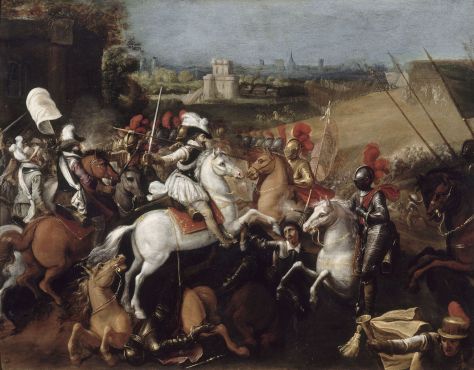
Henri IV at the Battle of Arques (21 September 1589), oil on wood, 1st quarter of the 17th c. Musée national du château de Pau, Inv. P. 84-14-1.
The King’s Musketeers (aka the Mousquetaires du Roi or the Mousquetaires de la Garde) were formed by King Louis XIII of France in 1622. It was an evolution of the Carabins unit that Louis XIII’s father, Henri IV, formed in 1600. The Carabins were a light cavalry unit armed with arquebuses (aka calivers or carbines) and were renowned for their shooting accuracy. These Carabins were dispersed among the other light cavalry (cheveau legers) of the French army and often carried out reconnaissance missions.
In 1622 during the first siege of La Rochelle, Louis XIII rejoined the Carabins and replaced the arquebuses with the heavier matchlock musket. It was here that Louis XIII rebranded the unit as the King’s Musketeers and thus the legendary unit was born.
The Musketeers formally was unit under the king’s household and were a cavalry-infantry hybrid troop, trained to fight on horseback and on foot. Their hybrid role was partly due to musketeers being an infantry unit mixed with the Carabins being a mounted unit, plus most of the Musketeer recruits were from the gentry, a class who preferred the prestige of cavalry.
The Musketeers primarily served as escorts for the king when he left the palace, performed delicate missions for His Majesty, and were often part of the enfant pedus (“forlong hope” but literally “lost children” aka “the guys first into the fray & were most likely to die in battle”) during the 17th Century.
The Musketeers operated between 1622-1646 before Cardinal Mazarin had them disbanded under the pretext of “unnecessary expense.” In reality, Captain-Lieutenant Treville refused to give up his commission for Mazarin’s nephew who wanted the gig. The Musketeers of the King were later reformed in 1657 by Louis XIV and the role of captain-lieutenant went to Mazarin’s nephew, the Duc de Nevers. Big surprise there.
The unit went through several changes thereafter before officially being disbanded in 1775. But for the sake of this post and project, we’ll be looking at the Musketeers from 1622-1660(ish) where the bulk of the d’Artagnan Romances take place.
The King’s Musketeers Cassock Design
Uniforms weren’t much of a thing in 17th Century France until the later-half of the century. As for the King’s Musketeers, they had no formal uniform until 1673. Before then, they were easily identified by their cassocks (casaque).
Unfortunately, there are no extent examples of what the Musketeers cassocks looked like from this time period. The only physical Musketeer uniforms we have are from the 18th Century, so we’re left to go off what little etchings and portraits that remain (mostly post-1660s) and vague descriptions from historical figures and journals of the period.
Under Louis XIII, the Musketeers’ cassock was blue with a white cross on the front, back and each sleeve. Under the cassock, however, Musketeers wore what they chose — typically whatever they could afford and was fashionable at the time.
“The company combats on foot and on horseback, the men all dressed differently but all wear over their clothing –as a distinctive sign—the blue tunic, which is very short because it hangs just to the horse’s croup. It’s a sort of pelerine with broad, open sleeves upon which appear four white crosses: one on each side, one on the front, one on the back. The sight of these blue [tunics] with their white crosses terrorized their adversaries, such was the fighting skill and bravery of the musketeers!” —Clément Bosson
There were a few individual instances in which Louis XIII ordered for a more uniformed look. However, as a general rule, Musketeers would wear their normal clothing underneath their cassocks.
Other sources confirm the general look of a royal blue cassock with white crosses, adding that the original cassocks also had gold embroidered fleur-de-lis at the end of the cross’s arm. However, they fail to provide any reasoning or evidence to support that argument.
We don’t get another description about the Musketeers’ uniforms until two decades later. In 1642, Etat de la France stated that the Musketeers wore “blue cassocks distinguished with silver crosses.” This is reaffirmed in The State of France in 1648-1649:
“The mounted Musketeers of the King’s guard only mount the guard when the King goes out; they then proceed on horseback before all the other Guards, two by two. They all wear the blue tunic with the silver cross. Their captain is Monsieur de Tréville, which the defunct King had promoted to this position because of his great courage. They are one hundred thirty men and receive forty sols per day.” (“The State of France in 1648 – 1649” – F. Danjou. Archives, Curiosities of the History of France, series 2, t. VI, p.432)
In 1656, Sieur de Verdier’s Le vray et nouveau estat de la France also noted that the Musketeers wore “all blue cassocks with a silver cross.”
In 1657, Phillipe de Villers gave us what might be the most detailed description of the uniform, noting that the Musketeers “had a blue cassock with a large silver crosses that had gold lilies at the end [of its arms] and flames [at the center]. The whole cassock is edged with silver lace.” Much like earlier iterations, the cassocks had the silver crosses on the front, back and sides of the cassock.
Villers’ description is confirmed in the Journal from a voyage to Paris in 1657-1658 which called the Musketeers “well chosen” and “clothed magnificently.” The outfits consisted of “a blue tunic with large silver crosses with golden flames culminating in a lily. The entire tunic has silver braiding.”
These are the first written descriptions we have that mention a more decorative Musketeer cassock. Up until the late 1650s, the descriptions have been super simplistic as a blue cassock with a white/silver cross. These later descriptions add in colored trim, colored lilies at the end of the cross’s arms, and sunburst/flames at the center of the cross.
In the 1660s, after the creation of the Second Company of Musketeers, some distinctions were made in their dress. The First Company’s cassocks were decorated with gold braid while the Second Company was decorated in silver braid. They were also “lined in red” — the first time that we get any sort of hint of the inside of the cassocks.
The cassock started off as a short outer-garment that ended at around the thigh. Starting at 1660, the garment got longer, almost cloak-like, however, and became cumbersome to wear. Eventually Louis XIV nixed the cassock in favor of the soubreveste (a sleeveless coat). But it’s the cassock that most closely aligned with what pop-culture has given us over the decades.
The Musketeer emblem on this final cassock iteration is what we most often see in Hollywood renditions of the outfit. However, even in films set in the 1620s-1630s use this emblem despite it not being described as as such until the late-1650s into the 1660s. That’s a solid four decades where the written descriptions hint at much more simplistic design.
However, we do have a few illustrations from pre-1657, that shed a little more light on the Musketeer cassocks design.
Stefano della Bella (1610-1664) was an Italian printmaker known for his etchings of military and court scenes. In 1639, he went to Paris and in 1641 was commissioned by Cardinal Richelieu to document the Siege of Arras. In 1644, Cardinal Mazarin hired him to create some educational playing cards for the young Louis XIV. He later returned to Florence during the French Fronde.
In Bella’s works during his time in France, we find two etchings of “muskateers” from Various cavalry exercises. One of two mounted drummers and another of a rider galloping on horseback.
The etchings are circa 1642-1645 and give us a little more detail into the Musketeer cassocks that earlier written descriptions failed to illuminate. Both etchings show longer crosses with lilies at the end of the arms and flames protruding from the center. There are also hints of trim on the edges of the cassock.

This other Musketeer etching by Stefano della Bella’s hows a longer lower-arm cross with lilies caping the arms.
A 17th Century engraving (estimated circa 1636) shows Louis XIII at the Battle of Corbie, surrounded by a company of his Musketeers.
Like the Bella etchings, this artwork shows the Musketeers in a cassock with a cross capped with lilies. A slight sunburst can also be detected at the middle of each cross. Unlike the Bella etchings, however, these crosses seem to be a Greek cross (cross with equal lengths).

Detail of the Corbie etching shows the Musketeers in cassocks with a cross capped with lilies and a sunburst.
This is interesting as the Musketeer descriptions from the 1640s and earlier fail to mention the sunburst/flames and the lilies. Regardless, this seems to be the uniform of the King’s Musketeers from the mid-1630s leading up their disbandment by Mazarin in 1646.
The downside to these etchings is we don’t know the colors of the lilies or the flames, but if later renditions of the outfit is any indication then the lilies are gold, the flames a reddish/orange, the crosses white/silver, and the trim silver.
Fabric Used for the King’s Musketeers Cassocks
As mentioned previously, we have no extant examples of the Musketeers cassocks from Louis XIII and Louis XIV reign, and contemporary descriptions don’t get into the materials used. So we might never know for sure what the cassocks were made out of and lined with.
We can, however, make some educated guesses based on extant examples of similar garments, the role cassocks played, and what post-1660 Musketeer uniforms were made out of. We won’t be 100% sure that we’re right, but it’s the best we can do with the current available info.
The German National Museum (Geranischen Nationalmuseum Nurnberg) has an umhang which is a German cassock or cape. The cassock dates from 1620/30, so the timing is right at the beginning of the Musketeer’s lifespan. This cassock is collarless and made of felt wool and looks to be lined in linen.
The Rijks Museum has a cassock from around 1632 worn by Ernst Casimir of Nassau-Dietz during the Siege of Roermond. The body is made of wool and the lining of “fairly coarse, double-sided roughened wool fabric in linen binding.”
This is a nice example to draw from as it was worn by a soldier in battle, much like the Musketeers would’ve worn during their campaigns.
One of the main differences between these cassocks and the Musketeers’ cassocks are the buttons. The typical 17th Century cassock would have well over 100 buttons but there’s no mention of buttons on the Musketeer tunics nor any hint of buttons in the artwork.
In his military treatise, Instructions militaires, divisées en six livres, Jean de Billon lists the types of arms and armor a musketeer should be geared with. Among the armor was a roupille (a cape) “for the rain and this should be a little large.”
In England, a “cassock of broad Kentish cloth lined with cotton” was distributed to troops in 1599. Kentish cloth is wool and the cassock was a heavy coat intended for harsh weather conditions. This was the same for English troops during the English Civil War.
Cassocks were also used by musketeers during Thirty Year’s War in Europe. Johann Jacobi von Wallhausen, a German military writer, called it schützenrock (shooter’s coat) or cosacken. Wallhausen called it the only garment a musketeer needed as it was able to keep the bandoliers and musket from the rain.
These previous three examples are to give more credence to the idea that a King’s Musketeer cassock would primarily be made out of wool as it would provide protection the troop’s body and arms while traveling, on campaign and during battle.
The Reconstructing History cassock pattern (RH107) also lists silk as a potential lining option, though no reasoning or example was given in the “Historical Notes” section of the pattern.
As for the Musketeer cross, there’s even less to work off of. The only bit of info we have is from 1688 where it’s stated that the emblem was made of white velvet edged with silver lace and had gold lilies at the end of the arms of the cross. At the center were reddish/orange flames. This was the standard look from 1688 thereafter, though some historians believe this be the look earlier than 1688, too.
With all that in mind, it’s most probable that the King’s Musketeers cassock shell was made of wool and was lined with linen or cotton most likely and with the potential of a silk lining (if Louis XIII and XIV were generous with their coffers).
Design Summary: Putting This All Together
If someone’s looking to make their own King’s Musketeer tunic, here’s how I would advise them based on my current research. I’d keep the outer fabric wool and line the cassocks with lighter wool, linen, or, possibly, silk. For the cross, I would do some variation of the 1688 velvet with embroidery edging — though it might not be what they used in the 1620s-1660, it’s closest sample we have currently to work off of.
1622-1635(ish): Blue cassocks to mid-thigh with a white/silver cross on the front, back & sleeves.
1635-1642: Blue cassocks to mid-thigh with a silver Greek cross capped with gold lilies and with reddish/orange flames/sunburst at the cross center. Crosses are on the front, back and sides. Silver lace/braid trim around the edges of the cassock.
1641-1646: Blue cassocks to mid-thigh with a silver cross capped with gold lilies and with reddish/orange flames/sunburst at the cross center. Crosses are on the front, back and sides of the cassock. Crosses have longer bottoms.Silver lace/braid trim around the edges of the cassock.
1657-1660(ish): Blue cassocks to mid-thigh with a silver cross capped with gold lilies and with reddish/orange flames/sunburst at the cross center. Crosses are on the front, back and sides. Silver lace/braid trim.
1660s: Blue cassocks with a silver cross capped with gold lilies and with reddish/orange flames/sunburst at the cross center. Crosses are on the front, back and sides. Lined in red. Gold braid trim for the First Company and silver braid trim for the Second company. Cassocks start to get longer in length.
BONUS: Which Three Musketeer Movies Have the Most Accurate Cassocks?
Based on the research (cut, color, fabric, & design), here’s what I think are the most accurate King’s Musketeer cassocks from the movies. In no particular order:
The Three Musketeers (2013) (TV Mini-Series) [Russian]
The cassocks from this film and TV mini-series look straight out of the Bella etchings with the longer lower arm on the crosses.
The Three Musketeers (1939)
Amazingly, the Ritz Brother/Don Ameche comedy version of The Three Musketeers hits uniform pretty well (hat aside). This is a colorized version of their outfits from the movie which is in that classic black & white.
The Iron Mask (1929)
Hard to tell the colors used in Iron Mask starring Douglass Fairbanks, but we’ll give them the benefit of the doubt since they have the sunburst, the cross with fleur-de-lis caps and the edging. The downside is the tunics don’t seem to be embroidered or appliquéd on, but that could just be the image quality.
The Man in the Iron Mask (1939)
Another B&W film which makes the color a bit of a guess, but this film has all the other elements of the tunics, so makes the list.
Le Pré Aux Clercs (1891) [Musical]
This tunics were actually made for the comic opera Le Pré aux clercs. Music by Ferdinand Hérold. Playwright, Eugène de Planard. This one loses a few points for embroidering the edges all in red instead of the silver or gold mentioned in the text. But a solid look.
If you have additional resources that might shed light on some of the shadows of my research, please get in touch!
Sources:
French Musketeer 1622-1775, Rene Chartrand, Osprey Publishing
The Four Musketeers: The True Story of d’Artagnan, Porthos, Aramis & Athos, Kari Maund & Phil Nanson, Tempus Publishing
French Armies of the Thirty Year’s War, Stephane Thion, LRT Editions
Louis XIV’s Army, Rene Chartrand, Osprey Publishing
The Army of Gustaus Adolphus (1) – Infantry, Richard Brzezinski, Osprey Publishing
The Matchlock Musketeer 1588-1688, Keith Roberts, Osprey Publishing
“Cassock“, RH107, Reconstructing History (pattern)
Two muskateers with drums on horseback following a procession to the right, from ‘Various cavalry exercises’ (Diverses exercices de cavalerie), The Met Museum, https://www.metmuseum.org/art/collection/search/410819
A muskateer galloping towards the left, other horsemen galloping towards the left in background, from ‘Various cavalry exercises’ (Diverses exercices de cavalerie), The Met Museum, https://www.metmuseum.org/art/collection/search/410811
Le Monde de d’Artagnan, http://www.lemondededartagnan.fr/
The Real Musketeers!, Musee d’Armee, http://www.musee-armee.fr/ExpoMousquetaires/les-vrais-mousquetaires.html
“Musketeers of the Guard”, The Fleur de Lis, Too, http://lefleurdelystoo.blogspot.com/2009/08/mousquetaires-de-la-garde.html
“Stefano della Bella”, Wikipedia, https://en.wikipedia.org/wiki/Stefano_della_Bella
A Popular History of France From The Earliest Times Volume V. of VI., Francois Pierre Guillaume Guizot, https://www.gutenberg.org/files/11955/11955-h/11955-h.htm
France – Louis XIII at the Battle of Corbie, RV-432179, Roger-Viollet Collection, http://www.roger-viollet.fr/en/asset/link/106-person-depicted-in-the-image/LOUIS+XIII+OF+FRANCE/page/1#nb-result
“Osprey va a sacar un libro sobre los Mosqueteros Franceses de la Guardia”, Alabarda, Pica y Mosquete, http://alabarda-pica-ymosquete.blogspot.com/2013/06/osprey-va-sacar-un-libro-sobre-los.html
“Umhang (Überkleidung (Herren))”, T549, Geranischen Nationalmuseum, http://objektkatalog.gnm.de/objekt/T549
“Riding cloak of Ernst Casimir of Nassau-Dietz”, NG-NM-1097, Rijks Museum, http://hdl.handle.net/10934/RM0001.COLLECT.233740



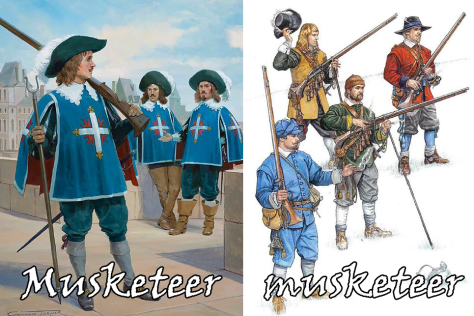

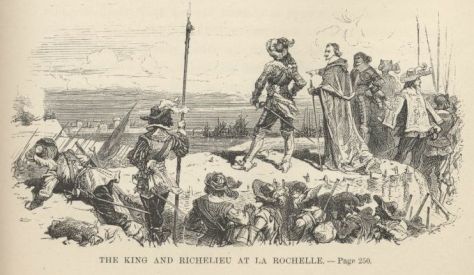
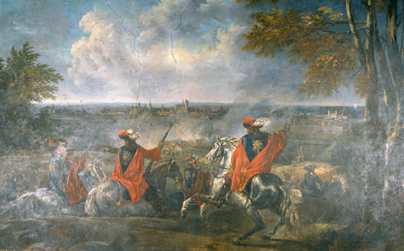

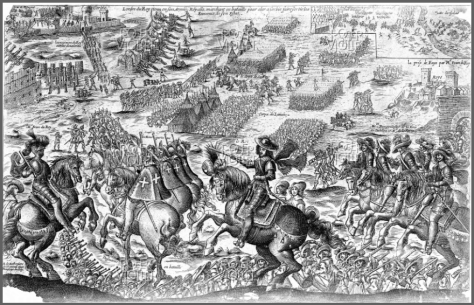
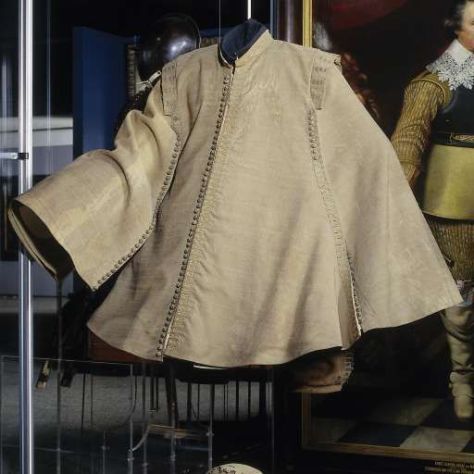
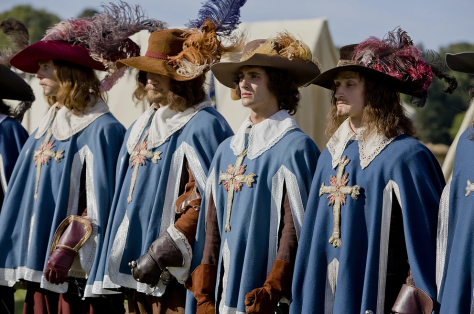
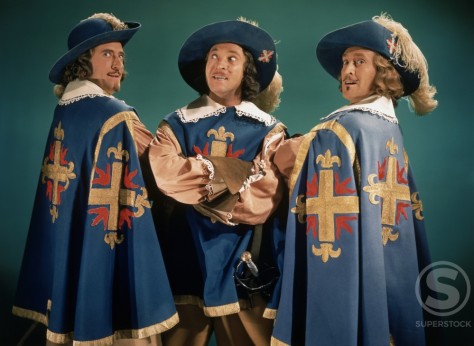

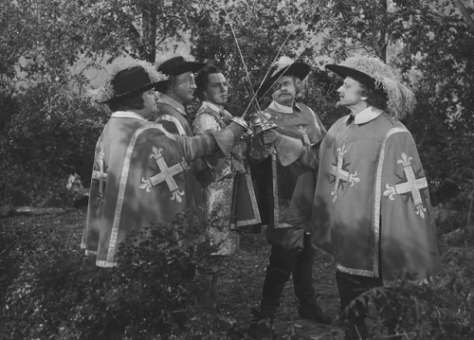
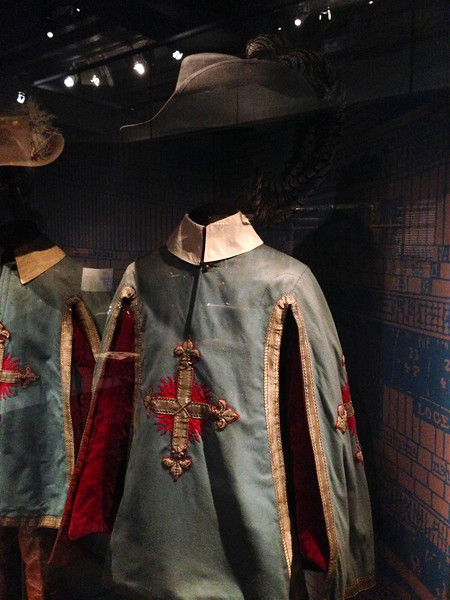
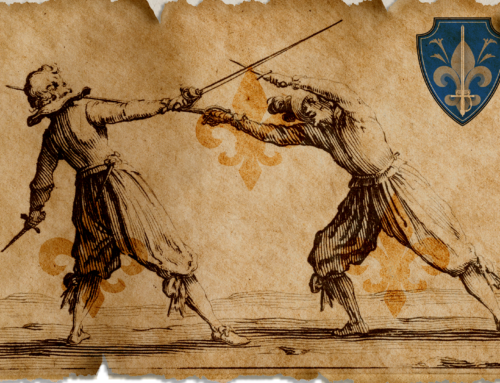
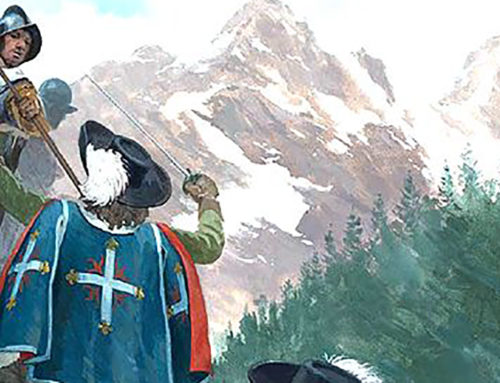
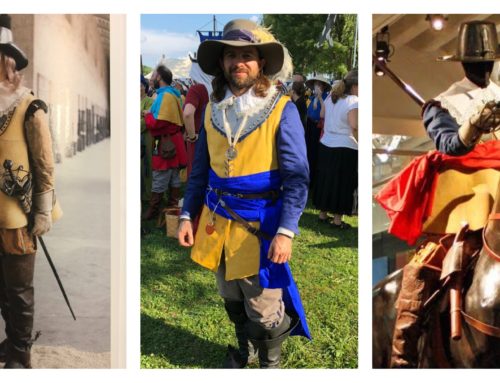
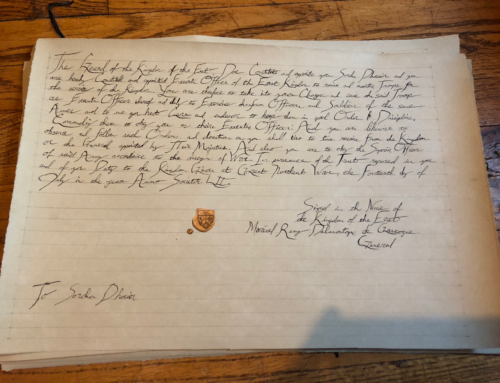
Thanks for this and the citations. I have a lot of reading to do.
You’re welcome and enjoy! 😀
Well Done, Remy. A nice research paper on the cassock. Interesting that the descriptions never mention buttons…
Thanks!
It’s possible that they didn’t have buttons? There’s not any sign of them in the sketches either.